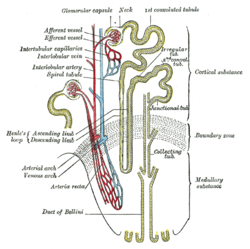| Loop of Henle | |
|---|---|
 Scheme of renal tubule and its vascular supply. (Loop of Henle visible center-left.) | |
| Details | |
| Precursor | Metanephric blastema |
| Identifiers | |
| Latin | ansa nephroni |
| Anatomical terminology | |
Renal stem cells are self-renewing, multipotent cells which are able to give rise to all the cell types of the kidney. It is involved in the homeostasis and repair of the kidney, and holds therapeutic potential for treatment of renal failure.[1]
Location edit
Strong evidence suggests that renal stem cells are located in the renal papilla[2]. Using stain-retaining assay (with bromodeoxyuridine, or BrdU), a low-cycling cell population was found in the papillary region, which was able to divide rapidly to repair the damaged caused by transcient renal ischemia.[2] These cells are able to incorporate into other renal tissues, and was able to repeatedly for spheres in 3D cultures, and clonal analysis also exhibited its multipotency.[2]
Other reports have suggested the renal tubule and renal capsule to be the site of stem cells. The renal capsule contain stain-retaining cells which exhibited markers for mesenchymal stem cells; after their removal, recovery was significantly slower post-ischemic injury. These evidence suggests a stem cell population exists within the renal capsule.[3]
Marker for Stem or Progenitor cells edit
Using in vivo lineage tracing techniques, Lgr5+ cells were found to contribute to the nephron, specifically to the ascending limb of the loop of Henle's and the distal convoluted tubule. Thus, Lgr5+ cells can potentially be a marker for renal stem and/or progenitor cells.[4]
Therapy edit
There is much debate regarding the cells involved in repair after injury; while some suggests that stem cells are the sole driving force of repair, others suggests that cells dedifferentiate after damage to act like stem cells.[5] Alternately, it was also reported that differentiated tubular epithelial cells are the driving mechanism for regeneration after injury, using proliferative expansion as the mechanism.[6]
Multipotent mouse kidney progenitor cells (MKPC) were obtained from Myh9 targeted mutant mice. Injection of MKPC into mice post-ischemic injury saw the MKPC regenerating different cell lineages and was able to regenerate renal function and enhanced survival.[7]
Renal induced pluripotent stem cells edit
It has been reported that endogenous kidney tubular renal epithelial cells can be dedifferentiated into induced pluripotent stem cells by the treatment of only two factors - Oct4 and Sox2.[8]
References edit
- ^ Brodie, J. C.; Humes, HD (2005). "Stem Cell Approaches for the Treatment of Renal Failure". Pharmacological Reviews. 57 (3): 299–313. doi:10.1124/pr.57.3.3. PMID 16109837.
- ^ a b c Oliver, Juan A.; Maarouf, Omar; Cheema, Faisal H.; Martens, Timothy P.; Al-Awqati, Qais (2004). "The renal papilla is a niche for adult kidney stem cells". Journal of Clinical Investigation. 114 (6): 795–804. doi:10.1172/JCI200420921. PMC 516259. PMID 15372103.
- ^ . doi:10.1152/ajprenal.00406.2009.
{{cite journal}}: Check|doi=value (help); Cite journal requires|journal=(help); Missing or empty|title=(help); zero width space character in|doi=at position 4 (help) - ^ Barker, Nick; Rookmaaker, Maarten B.; Kujala, Pekka; Ng, Annie; Leushacke, Marc; Snippert, Hugo; Van De Wetering, Marc; Tan, Shawna; Van Es, Johan H. (2012). "Lgr5+ve Stem/Progenitor Cells Contribute to Nephron Formation during Kidney Development". Cell Reports. 2 (3): 540–52. doi:10.1016/j.celrep.2012.08.018. PMID 22999937.
{{cite journal}}: no-break space character in|first2=at position 8 (help); no-break space character in|first9=at position 6 (help); no-break space character in|last7=at position 4 (help); no-break space character in|last9=at position 4 (help) - ^ . PMID 17268398.
{{cite journal}}: Cite journal requires|journal=(help); Missing or empty|title=(help) - ^ Humphreys, Benjamin D.; Valerius, M. Todd; Kobayashi, Akio; Mugford, Joshua W.; Soeung, Savuth; Duffield, Jeremy S.; McMahon, Andrew P.; Bonventre, Joseph V. (2008). "Intrinsic Epithelial Cells Repair the Kidney after Injury". Cell Stem Cell. 2 (3): 284–91. doi:10.1016/j.stem.2008.01.014. PMID 18371453.
- ^ Lee, PT; Lin, HH; Jiang, ST; Lu, PJ; Chou, KJ; Fang, HC; Chiou, YY; Tang, MJ (2010). "Mouse kidney progenitor cells accelerate renal regeneration and prolong survival after ischemic injury". Stem cells (Dayton, Ohio). 28 (3): 573–84. doi:10.1002/stem.310. PMID 20099318.
- ^ Montserrat, N.; Ramirez-Bajo, M. J.; Xia, Y.; Sancho-Martinez, I.; Moya-Rull, D.; Miquel-Serra, L.; Yang, S.; Nivet, E.; Cortina, C. (2012). "Generation of Induced Pluripotent Stem Cells from Human Renal Proximal Tubular Cells with Only Two Transcription Factors, Oct4 and Sox2". Journal of Biological Chemistry. 287 (29): 24131–8. doi:10.1074/jbc.M112.350413. PMC 3397840. PMID 22613719.
{{cite journal}}: CS1 maint: unflagged free DOI (link)